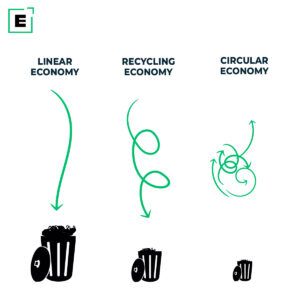SDA Bocconi’s Fashion Management Program is a Big Step to Drive Sustainability

Prestigious design schools like SDA Bocconi will tell you that fashion is more than just colors, forms, and aesthetics. It is also about history, art, utilitarianism, and sustainability. Experts will also tell you that in order to succeed in this field, the numbers will need to guide you. And the numbers say that the fashion industry contributes 8-10% of global carbon emissions as per UN estimates. Not very encouraging, is it? The fast fashion products are appealing and trendy, however, they cost us all in environmental currency. Is there a silver lining to this carbon cloud? Yes!

It is estimated that the sustainable fashion industry will account for $15 billion by 2030. Making your wardrobe more sustainable with smarter choices can help save the planet and also generate billions of dollars in revenue.
Slow fashion may be the way ahead for the garment industry but it is by no means a simple choice to make for manufacturers or designers. Sustainable fashion or circularity as a business model is not easy to implement. It requires commitment on the part of all stakeholders including end-users, investors, designers, manufacturers, and everyone in between. Additionally, it would require the right education to execute this from end-to-end.
It is, thus, a matter of pride to see that reputed business schools like SDA Bocconi, Milan, are setting a precedent by introducing programs like Circular Fashion Management. Such programs from SDA Bocconi will provide executives in the fashion industry the perspective and the tools they need to steer their companies in the direction of sustainability.
But for the uninitiated, here is what the business of circularity in fashion entails.
What is circular fashion?

Circular fashion is a relatively new concept in the fashion industry. While it ties back to the buzzword of sustainability, it has more clearly defined outcomes. Sustainability is a commitment to ensure that we do not take away resources from the planet at a faster pace than they can be replenished by nature. The 3P model of sustainability takes into account Planet, People, and Profits. This is a larger concept and circularity lies within it.
In circular fashion, garments are ‘designed with high longevity, resource efficiency, non-toxicity, biodegradability, recyclability and good ethics in mind.’ as per Anna Brismar of Green Strategy, a fashion consultancy. Clothes produced under this system have longer shelf life and can also be mended to last longer.
Moreover, they can be recycled in parts or fully to produce new garments. In this way, we are reusing the same resources to produce more clothes and minimizing wastage.
What are the challenges to a circular fashion economy?
#1: Scalability
Reclaiming discarded garments and recycling them into new ones seems like a great idea when you do it for a college project. But imagine scaling this model out of your garage into a global fashion brand. Scaling up is a challenge because one must streamline the supply chain for raw materials (in this case, reclaimed garments) to deliver at the rate at which the company is making new clothes.
Some brands have managed to overcome the challenge of scalability. For instance, Lagos-based designer Adebayo Oke-Lawal uses a supply chain that is 90 percent local to Nigeria. His supply chain spans material sourcing, dyeing, printing, and everything in between. His brand, Orange Culture is known for its gender-fluid designs and the thriving community the brand has built as a result of its circularity.
#2: Affordability
It is a well-known fact that sustainable fashion items cost more than regular clothes. This is simply because it requires much more effort to reclaim garments, process them, and recreate designs. The long supply chain of circular brands pushes up the price of the end-products. Considering price is one of the most effective levers for any business, how do you make circular fashion a viable buying option ?
The answer to this question lies in another question. Why do people buy a shirt from a luxury brand when they can get a similar shirt from a high-street store? The reason is that the value-proposition for fashion items is more than just a shirt or a pair of denims. People often buy what the brand represents. We buy Levis, not just a pair of jeans. So, the way to overcome the challenge of affordability is to sell the benefits of circular fashion to the end-users. Brands can actually cut the clutter by going circular!
#3: Profitability
No business can survive without making profits. But, how do you make profit that is equitable and ethical to people and the planet? The trick is to find that unique business model. For instance, Christopher Raeburn started his UK-based brand Raeburn in the early 2000s by purchasing unused military jackets at subsidized prices and making fashionable garments from them.
Is circularity the future of fashion?
 We can look at circularity as both the past and the future of fashion. The concept is new to multi-nationals but in the East or Africa, circularity has been the way of life. The concept of circularity in economics may be new, but it is not new to philosophy. For instance, Tao’s philosophy of living in moderation and balance with nature. Or the Hindu concept of reincarnation; so the end of the life for one being is the beginning of another life. In essence, these philosophies represent the circularity of life.
We can look at circularity as both the past and the future of fashion. The concept is new to multi-nationals but in the East or Africa, circularity has been the way of life. The concept of circularity in economics may be new, but it is not new to philosophy. For instance, Tao’s philosophy of living in moderation and balance with nature. Or the Hindu concept of reincarnation; so the end of the life for one being is the beginning of another life. In essence, these philosophies represent the circularity of life.
Looking ahead, circularity will certainly be a competitive advantage in the near future. And its success as a business model will grow as people become more conscious of what they buy. This is particularly true in the post pandemic world. Trends suggest that luxury brands will be the first ones to embrace circularity. So brand will need executives who are well-versed with this developing field of business to steer them in the right direction.
SDA Bocconi has started this unique course in Circular Fashion Management that can help you stay ahead of the curve. You could be a senior executive for a fashion brand or a designer on the cusp of starting your own brand, this program can help you drive your respective businesses toward circularity. The course by the renowned fashion school will focus on concepts like fashion footprint and sustainability while addressing real-time business problems like sourcing raw materials ethically, streamlining supply chain, and staying profitable with circularity. This SDA Bocconi course will include in-depth case studies of brands like Stella McCartney that have chosen circularity.
By Anwesha Barari
Write to content@emeritus.org with your feedback.




